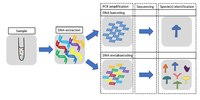
Photo from wikipedia
Environmental DNA (eDNA) metabarcoding surveys enable rapid, noninvasive identification of taxa from trace samples with wide‐ranging applications from characterizing local biodiversity to identifying food‐web interactions. However, the technique is prone… Click to show full abstract
Environmental DNA (eDNA) metabarcoding surveys enable rapid, noninvasive identification of taxa from trace samples with wide‐ranging applications from characterizing local biodiversity to identifying food‐web interactions. However, the technique is prone to error from two major sources: (a) contamination through foreign DNA entering the workflow, and (b) misidentification of DNA within the workflow. Both types of error have the potential to obscure true taxon presence or to increase taxonomic richness by incorrectly identifying taxa as present at sample sites, but multiple error sources can remain unaccounted for in metabarcoding studies. Here, we use data from an eDNA metabarcoding study designed to detect vertebrate species at waterholes in Australia's arid zone to illustrate where and how in the workflow errors can arise, and how to mitigate those errors. We detected the DNA of 36 taxa spanning 34 families, 19 orders and five vertebrate classes in water samples from waterholes, demonstrating the potential for eDNA metabarcoding surveys to provide rapid, noninvasive detection in remote locations, and to widely sample taxonomic diversity from aquatic through to terrestrial taxa. However, we initially identified 152 taxa in the samples, meaning there were many false positive detections. We identified the sources of these errors, allowing us to design a stepwise process to detect and remove error, and provide a template to minimize similar errors that are likely to arise in other metabarcoding studies. Our findings suggest eDNA metabarcoding surveys need to be carefully conducted and screened for errors to ensure their accuracy.
Journal Title: Molecular Ecology Resources
Year Published: 2020
Link to full text (if available)
Share on Social Media: Sign Up to like & get
recommendations!